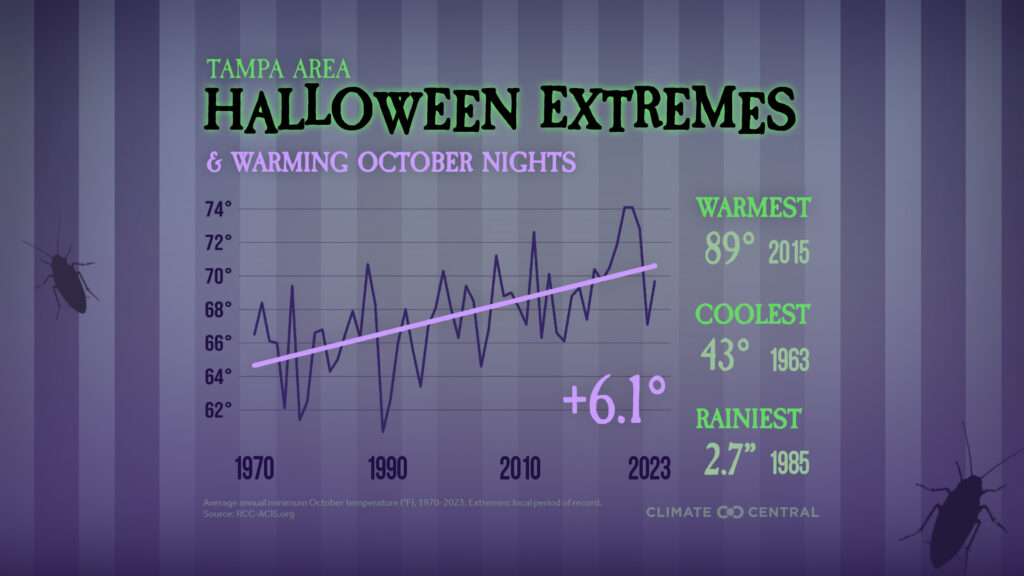By Laurie Mermet, The Invading Sea
Fall has been losing its familiar chill, and this Halloween will be no exception.
Across the U.S., 234 cities have experienced warming fall temperatures since 1970, Climate Central reports. On average, fall temperatures have increased by 2.5 degrees Fahrenheit across the U.S., and the warming trend is having widespread impacts on health, wildfire risk, agriculture and ecosystems.
“(Fall) is being shortened on both sides,” said Shel Winkley, a meteorologist with Climate Central. “You have this summertime heat that is eating into fall. We’re not seeing those pumpkin spice temperatures or those nice, cool temperatures that we expect to see as we hit those fall seasons … So the season’s getting shorter itself.”

The trend can also be seen in warming October nights. In Florida, Panama City has seen average nighttime October temperatures climb by 9.1 degrees since 1970, from an average of 54 degrees to roughly 63 degrees. The Tampa area has seen a 6.1-degree increase over the same period.
“Specifically with Panama City being so close to the coast, I think that those water temperatures are one of the reasons that we’re seeing the overall temperature being held up,” Winkley said. He added that with a warming climate, the atmosphere can hold onto more moisture, which provides more humidity that comes in at night.
For every one degree of warming, the atmosphere can hold onto 4% of moisture, he said.
Below Panama City and Tampa lies Sarasota with a 7-degree increase in average nighttime October temperatures, Tallahassee with a 5.2-degree increase and Miami with a 3.3-degree increase.
According to Winkley, Florida has seen about a two-to-three degree warming trend over the last 50 years.
Nationwide, fall warming is most intense in the Southwest, but it is a widespread phenomenon affecting 80% of the locations analyzed in the report. Many cities now experience more frequent above-normal fall days.
“Nighttime temperatures are actually warming two times faster than daytime temperatures,” Winkley said.
In 97 cities, the fall season lasts at least two additional weeks compared to 1970, with 10 locations – including parts of Florida, Nevada and California – reporting 30 or more days of above-normal temperatures, the report says.
As fall temperatures rise, health risks grow, especially for children, outdoor workers and urban populations vulnerable to the urban heat island effect – urban, less green areas that have higher temperatures compared to the areas surrounding them. Prolonged heat can also worsen allergies, extend wildfire seasons and disrupt ecosystems, including the timing of bird migrations and plant cycles.
For Florida and the rest of the U.S., this warming trend is part of a larger, long-term pattern.
“If we don’t start … switching over towards more renewable ways of getting our energy and less reliance on fossil fuels, then this trend will only continue to go up,” Winkley said.
Laurie Mermet is a Florida Atlantic University senior majoring in multimedia journalism who is reporting for The Invading Sea during the fall 2024 semester. Banner photo: Pumpkins in the sun (iStock image).
Sign up for The Invading Sea newsletter by visiting here. If you are interested in submitting an opinion piece to The Invading Sea, email Editor Nathan Crabbe at ncrabbe@fau.edu. To learn more about the urban heat island effect, watch the video below.



